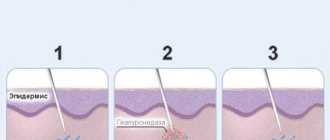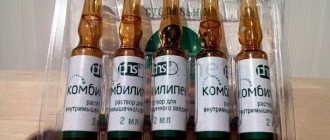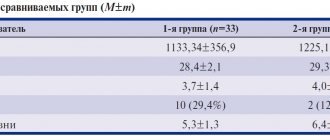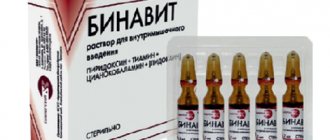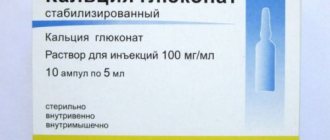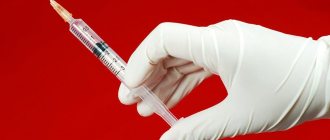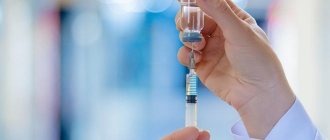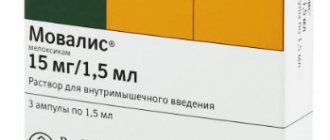Compound
1 ml of Progesterone 1% injection solution contains 0.01 grams of the active substance, as well as benzyl benzoate (Benzylii benzoas) and refined olive/peach oil (Oleum Olivarum/Oleum Persicorum).
One milliliter of injection solution Progesterone 2.5% includes 0.025 grams of the active substance, benzyl benzoate (Benzylii benzoas) and refined olive/peach oil (Oleum Olivarum/Oleum Persicorum).
Progesterone 1% and 2.5% is available in 1 ml ampoules, packaged in packages of 5 or 10 pieces.
The composition of the gel and capsules varies depending on which pharmaceutical company produces these dosage forms.
Pharmacodynamics and pharmacokinetics
Progestogen is a steroid hormone that is produced in the body by the corpus luteum of the ovaries .
The mechanism of action of progesterone drugs is associated with their ability to interact with specific progestin receptors, which are located on the surface of target cells.
By binding to them, the substance penetrates the cell nucleus, activates deoxyribonucleic acid and stimulates the synthesis of ribonucleic acid.
The effect on a woman’s body is that the drug:
- stimulates the transition of the endometrium (the mucous layer of the inner mucous membrane that lines the body of the uterus) from the proliferative phase, which coincides with the ovulatory and follicular phases of the ovarian cycle, to the secretory phase;
- creates optimal conditions for embryo , reduces the sensitivity of the uterus and fallopian tubes to the action of oxytocin and has a tocolytic effect;
- stimulates lipoprotein lipases ;
- increases body fat reserves;
- helps increase the level of induced and basal (background) insulin glucose utilization ;
- enhances the accumulation of glycogen in the liver;
- stimulates the synthesis by the adrenal cortex of the mineralocorticosteroid hormone aldosterone ;
- provokes hypoazotemia ;
- increases the excretion of nitrogen-containing metabolic products in the urine;
- suppresses the production of a number of hypothalamic factors for the release of luteotropin (LH) and follicle-stimulating hormone (FSH) and, accordingly, the biosynthesis of pituitary gonadotropic hormones ;
- reduces the permeability of the capillary wall in the tissues of the mammary glands;
- reduces swelling of the connective tissue framework, depending on the phase of the menstrual cycle ;
- suppresses the proliferative and mitotic activity of ductal epithelial tissue (in the case when progesterone is used in the form of a gel).
When taken orally, intravaginally using the drug in capsules, or injecting an injection solution under the skin and into the muscle, the substance is quickly absorbed. When applied to the skin in gel form, it is almost not absorbed and does not enter the systemic circulation.
The maximum plasma concentration when taking the tablet orally is observed after 1-3 hours; with intravaginal application, this figure is achieved after 2-6 hours.
protein binding (mainly albumin (approximately 50–54%) and 43–48% corticosteroid binding globulin ).
In the liver, the substance is biotransformed into inactive metabolites (mainly pregnanediol and pregnanolone ).
From 50 to 60% of the substance is eliminated by the kidneys , more than 10% - with bile ; Progesterone metabolization products excreted in bile intestinal and can undergo enterohepatic recirculation .
Indications for use
Progesterone: What is it for in oral capsule form?
Taking capsules is indicated for premenstrual syndrome and if a woman is diagnosed with fibroadenomatosis (fibrocystic disease).
As a progestational component, the drug is prescribed for HRT ( hormone replacement therapy ) in the period preceding menopause , immediately during menopause (including if menopause is premature ), as well as in the postmenopausal period .
Capsules for intravaginal administration: indications for use
Capsules for intravaginal use are indicated:
- if it is necessary to prescribe HRT to a woman in case of ovarian dysfunction accompanied by a lack of progesterone ( oocyte donation );
- to maintain the luteal phase during preparation for IVF ;
- to maintain the luteal phase in the induced or spontaneous menstrual cycle .
For prophylactic purposes, the drug is prescribed to prevent habitual and threatening spontaneous abortion caused by gestagen insufficiency ; for endocrine infertility ; to prevent the development of fibroids and endometriosis .
Indications for use of the oil solution
Since progesterone causes menstruation (if their delay is associated with a deficiency of this hormone), it is prescribed to correct various types of menstrual irregularities .
Thus, the use of an oil solution is advisable for amenorrhea (absence of menstrual bleeding for several cycles) and oligomenorrhea (that is, a delay in menstrual bleeding for more than 40 days).
In addition, injections are prescribed for:
- algomenorrhea (painful periods) associated with insufficiency of the gonads
- anovulatory metrorrhagia (uterine bleeding not associated with ovulation);
- endocrine infertility (including those caused by insufficiency of the corpus luteum);
- threat of spontaneous abortion ;
- diagnostic procedures, the purpose of which is to determine the level of estrogen+ .
When menstruation is delayed, progesterone can be used both in tablet form and in injections. However, more often an injection solution is prescribed, since the effect after it is noticeable much faster than after taking tablets.
Indications for use of the gel
Applications using Progesterone in gel form are prescribed for mastalgia and mastopathy .
secondary amenorrhea associated with progesterone deficiency , as well as in reproductive programs if a woman needs to compensate for the lack of progesterone during oocyte donation .
Norm of progesterone in women
The normative boundaries of progesterone are conditional indicators that cannot reflect pathologies associated with deficiency or increased content of the hormone in the circulatory system. But any deviation indicates problems in the body that require adjustments.
According to the phases of the menstrual cycle, progesterone norms in nmol/l are as follows:
- follicular – 0.32 – 2.25;
- ovulation period – 0.49 – 9.41;
- luteal – 6.95 – 56.63.
The difference in indicators can be significant due to the emotional state of the woman, the time of the test, heavy physical activity performed on the eve, as well as due to a particular lifestyle. During pregnancy, the rates are always higher.
Contraindications
All dosage forms of Progesterone are contraindicated:
- in case of hypersensitivity to the components of the drug;
- in the presence of serious impairment of renal function and/or hepatic function ;
- if the patient is diagnosed with hepatitis ;
- in the acute form of inflammation of the venous walls , as well as in acute thromboembolic diseases ;
- patients who have an increased risk of blood clots ;
- vaginal (vaginal) bleeding of unknown origin;
- missed miscarriage;
- incomplete abortion;
- porphyrin disease.
Additional contraindications to the use of an oil solution are:
- the presence of a malignant tumor of the mammary gland or genital organs (for breast carcinoma, exceptions are cases when progesterone is prescribed as part of complex therapy);
- pregnancy (starting from 14 weeks).
Side effects
Treatment with progesterone drugs can cause the development of allergic reactions.
The effect on a woman’s body of the drug in capsule form is in some cases accompanied by:
- increased drowsiness;
- dizziness that occurs 1-3 hours after taking the tablet;
- various types of menstrual cycle disorders (for example, a reduction in its duration or the appearance of intermediate bleeding).
The most common side effects of injections:
- acute blockage of the lumen of blood vessels by a thrombus;
- thrombophlebitis (thrombosis accompanied by inflammation of the venous wall);
- thrombosis of retinal blood vessels;
- increased blood pressure ;
- the appearance of edema ;
- chronic cholecystitis , characterized by the formation of stones in the gallbladder (calculous cholecystitis);
- increased drowsiness ;
- headache;
- apathy;
- visual impairment;
- hair loss ( alopecia );
- decreased libido ;
- hirsutism (male pattern hair growth in women);
- attacks of nausea and vomiting;
- deterioration of appetite and, as a result, loss of body weight;
- menstrual irregularities;
- cholestatic hepatitis;
- depression;
- dysphoria (gender identity disorder);
- release of milk from the mammary glands not associated with breastfeeding ( galactorrhea );
- enlargement, tenderness and tension of the mammary glands;
- local reactions (redness of the skin and pain at the injection site).
What is progesterone responsible for?
Progesterone is necessary for a woman during pregnancy and childbirth. The hormone ensures the endometrium’s receptivity to the fertilized egg, its implantation and further development. During the period of conception and in the first 4 weeks of pregnancy, progesterone is responsible for the threshold of excitability of the muscle fibers of the uterus. He increases it so that the woman bears the fetus during the period of its engraftment in the uterus.
In later stages of pregnancy, progesterone increases to inhibit the contractile activity of the uterus. The hormone increases the immunity capabilities of the mother's body so that it easily tolerates the influence of fetal antigens, and the woman calmly bears the fetus.
Receptors for progesterone in a pregnant woman are found not only in the ovaries and placenta. Their effects extend to the endometrium, myometrium, mammary glands, vascular endothelium, thymus, bones, bronchi, lungs and pancreas. A sufficient amount of it relaxes the smooth muscles of the uterus, blood vessels and bile ducts. Promotes the growth of glandular tissue of the mammary gland and prevents the mammary gland from secreting colostrum until birth.
Progesterone also affects brain structures such as the pituitary gland and hypothalamus. The cognitive process, memory, emotional stability, sexual desire, body temperature, as well as the holistic and healthy state of bone tissue depend on its high-quality production.
Outside of pregnancy, the hormone helps transform the endometrium. Cell division occurs, tissue grows and chemical elements are released from it. This process helps shed the endometrium and promotes the onset of a healthy menstrual cycle. The amount of progesterone in the circulatory system determines the health of a woman’s breasts, blood sugar levels, the rate of sebum production and blood pressure.
Instructions for Progesterone (Method and dosage)
Progesterone injections: instructions for use
Progesterone injections are given into the muscle or under the skin.
For dysfunctional uterine bleeding, daily administration of 0.5-1.5 ml of a one percent solution is indicated for 6-8 days. If the patient has undergone a uterine cavity curettage procedure, the course of injections begins after 18-20 days.
If curettage is not possible, the drug can be administered even during bleeding. When using Progesterone during bleeding, bleeding may temporarily increase (usually for 3-5 days).
For this reason, patients with moderate or severe forms of anemia are recommended to first transfuse 0.2-0.25 liters of donor blood. If bleeding has stopped, do not interrupt the course of treatment before 6 days. If the bleeding has not stopped after 6-8 days of treatment, it is considered inappropriate to continue administering the solution.
For algodismenorrhea (painful periods), treatment begins 6-8 days before the start of menstruation. Patients are advised to administer 0.5 to 1 ml of a one percent solution daily for 6-8 days. The course of treatment can be repeated several times.
For preventive purposes, to prevent spontaneous abortion, 0.5 to 2.5 ml of a one percent solution is administered daily or every other day. Injections continue to be given until the threatening symptoms disappear completely. In case of habitual miscarriage, the drug should be administered until the fourth month of pregnancy.
The maximum single and daily dose for adult patients when Progesterone is administered into the muscle is 0.025 g.
Progesterone to induce menstruation: how to inject when menstruation is delayed
For hypogonadism, amenorrhea , as well as to induce menstruation in case of delay, treatment begins with the prescription of estrogenic drugs. The goal of therapy is to achieve sufficient proliferation of endometrial cells . Upon completion of the course using estrogenic drugs, the patient is prescribed Progesterone injections.
Treatment involves administering 0.5 ml daily or every other day 1 ml of a one percent oil solution (in some cases, Progesterone 2.5% may be prescribed to induce menstruation). Typically, 5 to 10 injections are required.
Instructions for Progesterone in tablets and gel form
The tablets are taken orally (without being tied to the time of meals) or used intravaginally, the gel is used as a local remedy. The dosage regimen, optimal dosage form and duration of treatment are determined depending on the indications and characteristics of the course of the disease.
As a rule, the daily dose is from 200 to 400 mg of progesterone. To maintain the luteal phase during IVF, the patient is prescribed a dose of 600 mg of progesterone, with a frequency of applications 3 times a day (200 mg every 8 hours).
One application requires 2.5 g of gel (equivalent to 25 mg of progesterone). The gel is applied using a special dispenser applicator to the skin of the mammary glands once or twice a day daily (until completely absorbed) or in the second phase of the menstrual cycle (from the 16th to the 25th day). Treatment is usually carried out over 3 cycles.
A repeated course is possible according to indications.
In what cases is a progesterone test prescribed, how to prepare for it
Blood tests for progesterone in women are prescribed in the following cases:
- interrupted menstrual cycle or complete absence of signs of endometrial removal from the body for a long time;
- tenderness in the breast area or lower abdomen;
- heavy bleeding from the vagina both during and after menstruation;
- failure to carry a pregnancy to term due to spontaneous miscarriage;
- inability to conceive a child over a long period of time.
An analysis of the level of progesterone in the blood is mandatory for women in the second half of pregnancy to assess the condition of the placenta.
The most successful period for taking the test is the period of ovulation, that is, 22–23 days after the start of menstruation with a standard cycle of 28 days. If the cycle, for example, is 35 days, then day 28–29 is considered a good day for testing. Blood should be donated on an empty stomach. The last meal should be 6 – 8 hours before.
To get reliable results, you should not take antifungal, steroid drugs, or medications that regulate the functioning of the thyroid gland for three days. Three hours before going to the laboratory you should not smoke.
Interaction
Reduces the intensity of the action of anabolic steroid drugs , oxytoxic drugs (that is, agents that stimulate the contractile activity of the uterus gonadotropic hormones synthesized in the anterior lobe of the pituitary gland . Reduces the lactogenic effect of oxytocin .
When used simultaneously with diuretics , bromocriptine ; drugs that reduce high blood pressure ; systemic coagulants , immunosuppressants Progesterone enhances the effect of these drugs.
When taking the drug in combination with barbiturates , a decrease in its pharmacological activity is observed.
Progesterone reduces the effectiveness of anticoagulants.
Progesterone injection solution in oil 2.5% 1 ml ampoule 10 pcs. in Moscow
Latin name
Progesterone
International nonproprietary name
progesterone
Release form
Oily solution for intramuscular injection
Package
1 ml - ampoules (5) - contour cell packaging (2) - cardboard packs. 1 ml - ampoules (10) - cardboard boxes.
pharmachologic effect
Gestagen. Corpus luteum hormone. Causes a transition of the uterine mucosa from the proliferation phase caused by follicular hormone to the secretory phase, and after fertilization contributes to its transition to the state necessary for the development of a fertilized egg. Reduces the excitability and contractility of the muscles of the uterus and fallopian tubes, stimulates the development of the end elements of the mammary gland. Does not have androgenic activity. Progesterone has a weak effect on protein metabolism, promotes the deposition of fats and the accumulation of glucose in the liver, and also reduces the reabsorption of sodium in the renal tubules. Progesterone has a blocking effect on the secretion of hypothalamic release factors of LH and FSH, inhibits the formation of gonadotropic hormones in the pituitary gland and inhibits ovulation.
Indications
Dysfunctional uterine bleeding, metrorrhagia, amenorrhea, recurrent miscarriage. Contraception.
Directions for use and doses
The dosage regimen is individual. The dose, frequency and duration of treatment are determined according to the regimen depending on the indications and clinical situation.
Compound
2 ml of solution in olive oil contains active substance: progesterone 25 mg
Contraindications
Severe liver or kidney dysfunction, hepatitis, thromboembolic diseases, vaginal bleeding of unknown origin, breast carcinoma (except for cases in which progesterone is used as part of combination therapy for this disease).
Use during pregnancy and breastfeeding
In cases of extreme necessity, it is possible to use Progesterone during pregnancy if there is an established deficiency of corpus luteum hormones. Progesterone is not used in women planning pregnancy in the near future.
special instructions
Progesterone is used with caution in patients with cardiovascular diseases, impaired liver or kidney function, diabetes mellitus, bronchial asthma, epilepsy, migraine, and depression.
Side effects
From the cardiovascular system: increased blood pressure. Metabolism: edema. From the digestive system: liver dysfunction, jaundice; rarely (with long-term use) - nausea, vomiting. From the endocrine system: rarely (with long-term use) - decreased libido, weight gain, pain and tension in the mammary glands, irregular uterine bleeding. From the side of the central nervous system: rarely (with long-term use) - headache, depression.
Drug interactions
Reduces the intensity of the action of drugs that stimulate the smooth muscles of the uterus, anabolic steroids, gonadotropic hormones of the anterior pituitary gland. Reduces the lactogenic effect of oxytocin. Enhances the effect of diuretics, antihypertensive drugs, immunosuppressants. When used simultaneously with barbiturates, a decrease in the effect of progesterone is observed.
Storage conditions
At a temperature not exceeding 25 C.
special instructions
Use with caution and under constant monitoring for diseases of the heart and blood vessels , epilepsy , mild or moderate renal dysfunction , for the treatment of diabetics, patients suffering from bronchial asthma and migraines .
Progesterone is also prescribed with caution to patients with a history of mental disorders . When the first signs of depression occur, treatment is stopped. You should also pay attention to early signs of thromboembolism . Their appearance is a reason to discontinue the drug.
Patients with diabetes mellitus during treatment with Progesterone should constantly monitor blood glucose levels .
Since steroid hormones are metabolized in the liver, progesterone is not prescribed to patients with impaired liver function .
Treatment with progesterone drugs may be accompanied by a weakening of concentration, so care should be taken when driving vehicles and engaging in other activities that require a high speed of psychomotor reactions or pose a potential threat to health and life.
Long-term use of increased doses of Progesterone can cause cessation of menstruation.
The drug in gel form is applied without rubbing it into the skin of the mammary glands or massaging them. After applying the cream, you should not be in direct sunlight.
Analogs
Matches by level 4 ATX code:
Iprozhin
Utrozhestan
Crinon
Prajeesan
Progestogel
Progesterone-containing drugs are Utrozhestan , Iprozhin , Crinon , Prajisan , Progestogel , Endometrin . A multicomponent analogue of the drug - vaginal capsules Triozhinal .
Use of Progesterone during pregnancy
Tablets and injections during pregnancy are indicated only in cases where it is necessary to prevent spontaneous miscarriage. There are no reliable data on the safety of using the drug in gel form during pregnancy.
During breastfeeding, you should refrain from using Progesterone tablets and injections. The gel is prescribed when there are no alternative treatments and the benefit to the mother potentially outweighs the risk to the baby.
There is an opinion that the drug helps get rid of an unwanted pregnancy, which is why the questions often arise: “How to disrupt an early pregnancy with the help of Progesterone?”
However, this is impossible, since progesterone, on the contrary, helps strengthen pregnancy (for this reason, the drug is prescribed to women who have been diagnosed with infertility, as well as to women who are about to undergo IVF). But a deficiency of this hormone can lead to miscarriage.
Low progesterone
Lack of the hormone in the body can cause spontaneous miscarriage. During conception, the mother's body does not receive the appropriate signals to begin preparing for pregnancy. When a new monthly cycle begins, the fertilized egg is expelled from the uterus and the pregnancy is terminated.
A lack of progesterone is often observed in the short luteal phase, if less than 10 days pass from ovulation to the onset of menstruation. The duration of this phase can be calculated by keeping a graph of basal temperature.
A decreased level of the hormone after ovulation indicates a hormonal imbalance, the causes of which are:
- decreased activity of the placenta or corpus luteum;
- uterine bleeding at the end of menstruation;
- miscarriage;
- post-term pregnancy;
- chronic inflammation in the reproductive system;
- defective intrauterine development of the child;
- taking certain medications;
- chronic inflammation of internal organs;
- development of primary and secondary amenorrhea.
When progesterone levels are low, a woman experiences painful and heavy menstruation, the mammary glands become enlarged, headaches begin, and irritability appears. In addition, the legs may swell, the skin may turn pale, and hair may fall out. Increased sweating occurs, sleep is disturbed and constipation is tormented.
The very fact that progesterone concentration deviates in one direction or another from the norm does not always make it possible to establish the cause of this phenomenon. Additionally, the doctor may prescribe hormone tests and send you for a pelvic ultrasound.
Reviews about Progesterone
The largest number of reviews about the drug can be found on special forums dedicated to the problem of female infertility.
Most women who have had difficulty conceiving and bearing a child note the effectiveness of Progesterone, even in cases where the patient suffered several miscarriages before starting a course of using this drug when another pregnancy occurred. That is, in some cases, Progesterone is the only chance to save a pregnancy.
However, there are also negative reviews about the drug. They are associated with a fairly large number of side effects of the drug and the presence of contraindications to its use. In addition, some of the women treated with Progesterone did not notice any effect from the prescribed therapy.
Be that as it may, as is the case with other medications, self-medication with progesterone preparations is unacceptable. You can begin a course of use only after a comprehensive examination and based on test data.
Increased progesterone
An increase in the hormone is observed in women in the middle of the menstrual cycle. Characterized by a slight increase in body temperature. An increase can also be observed during pregnancy. This is quite normal and should not bother a woman.
But if progesterone levels are regularly elevated, this may indicate the presence of the following conditions:
- renal failure;
- uterine bleeding not associated with menstruation;
- corpus luteum cyst;
- excess or insufficient production of hormones in the adrenal glands;
- uncontrolled use of medications.
An increased level of progesterone in the blood gives corresponding symptoms. Pimples appear on the skin and excess hair forms on the body. The woman begins to gain weight quickly and is tormented by fatigue and stress. The menstrual cycle is disrupted and a persistent allergic reaction to any allergen appears. At the same time, blood pressure constantly jumps and painful sensations appear in the mammary gland.
If there is no menstruation for more than 6 months, but the fact of pregnancy is excluded, then the level of progesterone increases significantly. A woman needs to undergo additional examination to identify the cause of this condition and prescribe appropriate treatment.
Progesterone price, where to buy
The price of injections in Russia is from 105 rubles for a package of ampoules with a one percent solution and from 360 rubles for a package of ampoules with a 2.5% oil solution. You can buy tablets for an average of 180 rubles (the price depends on the place of purchase, the manufacturer of the drug, the concentration of the active substance in one tablet and the number of tablets in the package).
In Ukrainian pharmacies the price of Progesterone in tablets is on average 45 UAH. The cost of ampoules with a 1% solution is from 12 UAH, ampoules of 2.5% cost an average of 32 UAH.
- Online pharmacies in RussiaRussia
- Online pharmacies in UkraineUkraine
- Online pharmacies in KazakhstanKazakhstan
ZdravCity
- Progesterone solution for in.
oil 1% 1ml 10 pcs. JSC Dalkhimfarm RUR 379 order
Pharmacy Dialogue
- Progesterone (amp. 2.5% 1ml No. 10) DHF JSC
934 rub. order
- Progesterone (amp. 1% 1ml No. 10) DHF JSC
RUB 312 order
show more
Pharmacy24
- Progesterone 1% 1 ml No. 10 solution TOV FZ Biopharma, Ukraine
68 UAH order - Progesterone 2.5% 1 ml No. 10 solution TOV FZ BIOPHARMA, Ukraine / PrAT Biopharma, Ukraine
75 UAH order
- Oxyprogesterone capronate 12.5% 1 ml No. 10 solution for injection TOV"FZ "Biopharma", Ukraine
114 UAH order
PaniPharmacy
- Oxyprogesterone capronate ampoule Oxyprogesterone capronate solution d/in. 12.5% amp. 1ml No. 10 Ukraine, Biopharma CJSC
114 UAH order
- PROGESTERONE ampoule Progesterone solution oil. d/in. 2.5% amp. 1ml No. 10 Ukraine, Biopharma CJSC
57 UAH order
- PROGESTERONE ampoule Progesterone solution oil. d/in. 1% amp. 1ml No. 10 Ukraine, Biopharma CJSC
59 UAH order
show more
